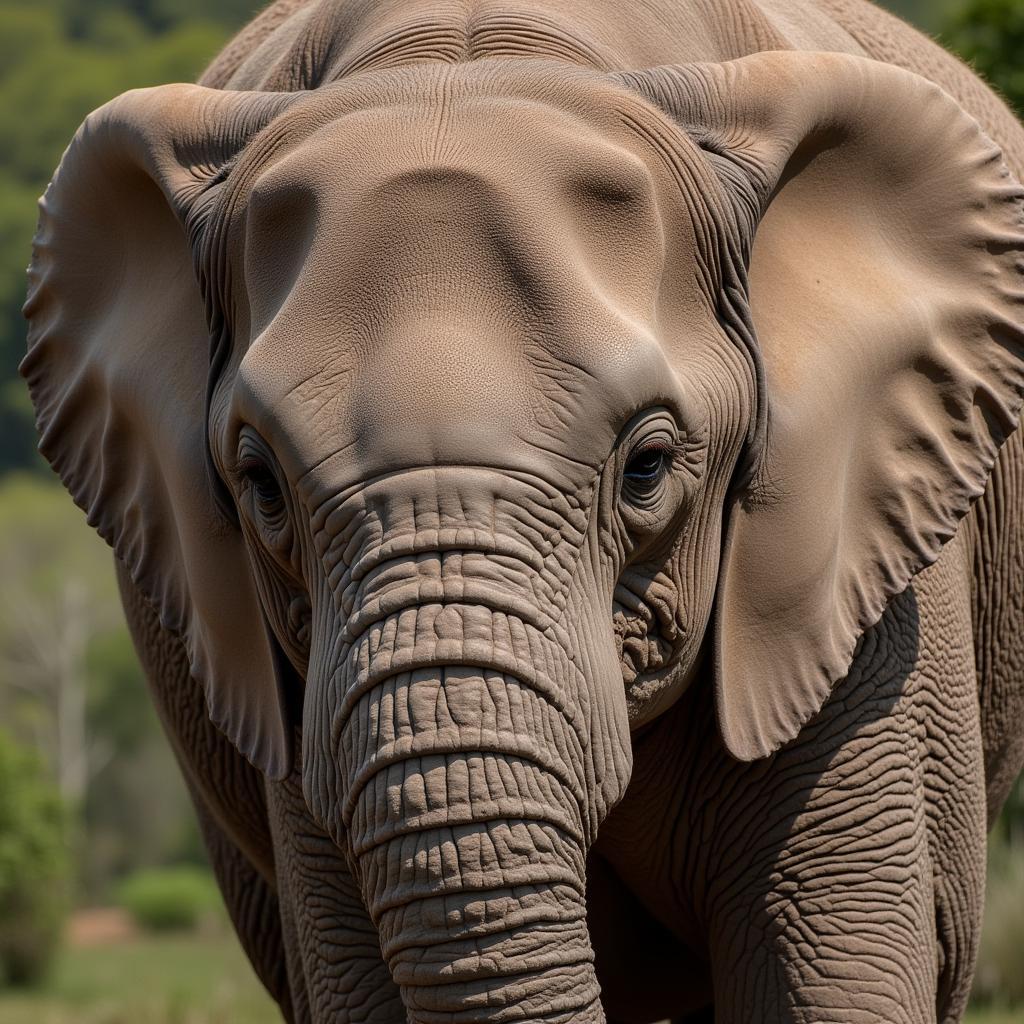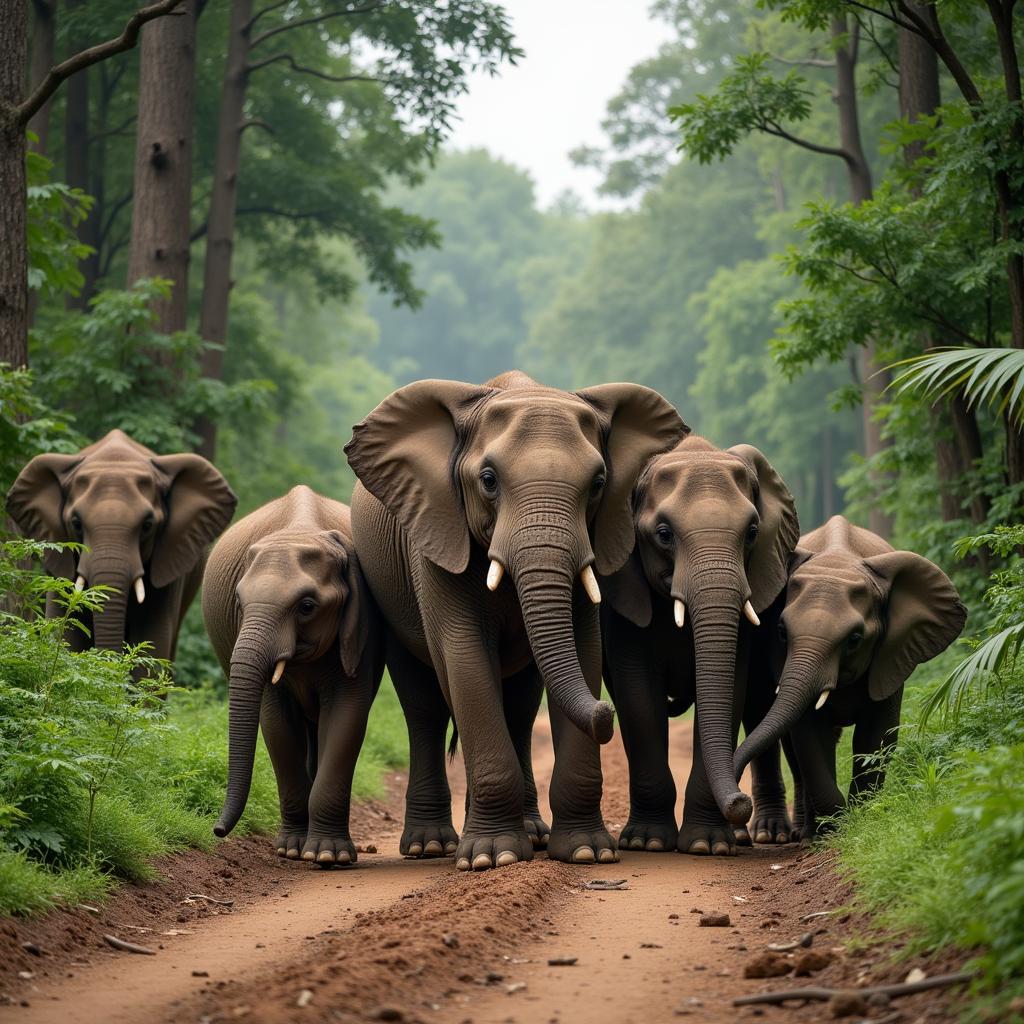African Forest Elephant Skin: A Closer Look
The African Forest Elephant Skin, a seemingly rugged and tough exterior, plays a critical role in the survival of this magnificent creature. Often overlooked, the skin of these gentle giants holds fascinating secrets, intricately woven into the fabric of their daily lives in the heart of Africa’s dense forests.
Unraveling the Mysteries: African Forest Elephant Skin Anatomy
The skin of an African forest elephant, unlike its savannah counterpart, is covered in a sparse coat of hair, making its texture more pronounced. This leathery armor, ranging in color from gray to brownish-gray, can be up to 2.5cm thick in certain areas, providing considerable protection from predators and parasites.
A Closer Look at the Dermis: The Skin’s Support System
Beneath the tough exterior lies the dermis, a complex layer rich in blood vessels and nerve endings. This intricate network plays a crucial role in thermoregulation, allowing the elephant to maintain a stable body temperature despite the humid and fluctuating temperatures of the rainforest.
 African Forest Elephant Skin Texture
African Forest Elephant Skin Texture
Sensory Perception: Feeling the Forest Through Skin
The dermis is also home to a high concentration of sensory receptors, enabling the elephant to detect even the slightest vibrations and changes in pressure. This heightened sensitivity allows them to navigate dense undergrowth, locate water sources, and even communicate with other elephants through subtle seismic signals.
Adaptations for Survival: The Importance of Elephant Skin
The African forest elephant’s skin is not just a protective barrier; it’s a testament to years of evolution, showcasing remarkable adaptations that have allowed these animals to thrive in their challenging environment.
Wrinkles: More Than Meets the Eye
The deep wrinkles and folds characteristic of elephant skin serve a vital purpose. These intricate patterns increase the surface area, facilitating heat dissipation and preventing overheating. The wrinkles also trap moisture, creating a mud cake that acts as a natural sunscreen and insect repellent.
Hair Today, Gone Tomorrow: The Role of Sparse Hair
While seemingly insignificant, the sparse hair covering on an African forest elephant’s skin plays a role in regulating body temperature. These hairs, more abundant in calves, provide insulation and aid in thermoregulation.
 African Forest Elephant Taking a Mud Bath
African Forest Elephant Taking a Mud Bath
A Delicate Balance: Skin Health and Environmental Challenges
Despite its resilience, the African forest elephant’s skin is susceptible to various threats. Parasites, infections, and injuries pose significant risks, highlighting the importance of maintaining a healthy ecosystem for these animals to thrive.
Conservation Implications: Protecting the Giants and Their Skin
As human activities encroach upon their natural habitat, African forest elephants face increasing threats, impacting their skin health and overall well-being. Deforestation, habitat fragmentation, and poaching all contribute to the decline of these magnificent creatures.
The Ivory Trade: A Threat to Elephants and Their Skin
The illegal ivory trade remains a significant threat to African elephants, both forest and savannah. Poachers often target older individuals with larger tusks, removing not just the ivory but also a significant portion of the elephant’s face, leaving behind a gaping wound that is not only physically traumatic but also susceptible to infections.
Raising Awareness: The Importance of Education and Conservation Efforts
Protecting the African forest elephant and its remarkable skin requires a multi-faceted approach. Raising awareness about the plight of these animals, supporting conservation organizations working to protect their habitat, and promoting sustainable practices are crucial steps in ensuring their survival for generations to come.
Conclusion: Appreciating the Wonders of African Forest Elephant Skin
The African forest elephant skin, often overlooked, is a testament to the power of adaptation and the intricate relationship between an animal and its environment. Understanding the unique characteristics and challenges facing these gentle giants is crucial in our efforts to protect them and ensure their survival in the wild.
FAQs About African Forest Elephant Skin
1. What is the purpose of the wrinkles on an African forest elephant’s skin?
The wrinkles on an African forest elephant’s skin serve multiple purposes. They increase the surface area, allowing for better heat dissipation and preventing overheating. Additionally, the wrinkles trap moisture, which helps regulate body temperature and creates a mud cake that acts as a natural sunscreen and insect repellent.
2. How thick is an African forest elephant’s skin?
An African forest elephant’s skin can be up to 2.5cm thick in certain areas, providing considerable protection from predators and parasites.
3. How do African forest elephants use their skin to sense their surroundings?
The dermis, a layer beneath the elephant’s tough exterior, contains a high concentration of sensory receptors. These receptors allow elephants to detect even the slightest vibrations and changes in pressure, enabling them to navigate dense undergrowth, locate water sources, and communicate with other elephants through subtle seismic signals.
4. What are the main threats to African forest elephant skin health?
The main threats to African forest elephant skin health include parasites, infections, injuries, and the illegal ivory trade. Deforestation and habitat fragmentation also contribute to these threats by increasing stress and making elephants more susceptible to diseases.
5. How can I help protect African forest elephants and their habitat?
You can help protect African forest elephants by supporting conservation organizations working to protect their habitat, spreading awareness about the plight of these animals, and making sustainable choices in your daily life to reduce your impact on the environment.
Explore More About African Wildlife
Interested in learning more about the fascinating creatures that share our planet? Check out these related articles:
 African Forest Elephant Family Group
African Forest Elephant Family Group
For any inquiries regarding African wildlife conservation or to learn more about supporting our initiatives, please reach out to us:
Phone: +255768904061
Email: kaka.mag@gmail.com
Address: Mbarali DC Mawindi, Kangaga, Tanzania
Our dedicated team is available 24/7 to assist you. Together, let’s make a difference in preserving the wonders of the natural world.

